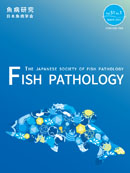
- 4 号 p. 127-
- 3 号 p. 83-
- 2 号 p. 39-
- 1 号 p. 1-
- |<
- <
- 1
- >
- >|
-
横山 博原稿種別: 総説
2023 年 58 巻 1 号 p. 1-7
発行日: 2023/03/15
公開日: 2023/04/17
ジャーナル フリーA myxozoan parasite Kudoa septempunctata causing the food poisoning of humans which consume raw olive flounder Paralichthys olivaceus has become a new threat to public health. This review focuses the recent occurrence of K. septempunctata-induced food poisoning in Japan for 10 years, the typical symptoms of the foodborne disease in humans, parasitology, diagnoses, countermeasures and the remaining issues. The numbers of K. septempunctata-induced cases and patients have peaked in 2014, followed by a gradual decrease in recent years. The symptoms of humans are characterized by transient vomiting and diarrhea. Also, onset of the disease is dose-dependent of fresh spores (> 1 × 107). The host fish for K. septempunctata is mainly limited to P. olivaceus. The geographical distribution is Japan and Korea. The two locality isolates are easily differentiated by a ratio of spores possessing 7 polar capsules. The light-microscopy, conventional or real-time PCRs, LAMP, immunochromatography have been developed for the diagnostic tools. To prevent the infection with K. septempunctata in juvenile stage of cultured flounder, a sand-filtration combined with ultraviolet irradiation (> 46 mJ/cm2) is effective. At the time of shipment of adult flounder, light-microscopic examination for spores is recommended to remove the infected fish group. The remaining problems include the disease mechanisms in humans, the host range, and the harmful Kudoa species other than K. septempunctata.
抄録全体を表示PDF形式でダウンロード (2502K)
-
Yuichi Furumoto, Makoto Kanamori, Masafumi Natsuike, Miku Kawahara, To ...原稿種別: Research Article
2023 年 58 巻 1 号 p. 8-14
発行日: 2023/03/15
公開日: 2023/04/17
ジャーナル フリーField surveys of the bacterium Francisella halioticida infection among intermediate-cultured juvenile scallops Mizuhopecten yessoensis in southern Hokkaido revealed that the mortality of juvenile scallops was positively associated with the prevalence of F. halioticida, and that both mortality and prevalence increased in September and January. In the intermediate culture experiments, juvenile scallops reared under high density during September and October resulted in high prevalence of F. halioticida and scallop mortality after October, while rearing density from October to March was not associated with infection and mortality, indicating that the high rearing density between September and October determined the infection of F. halioticida and scallop mortality in the following period. Furthermore, shell deformity rates, as a proposed index for poor physiological condition of juvenile scallops, were high in the experimental groups with higher density from September to October. The high rearing density in this term may have caused a decline in physiological status and, reduced resistance to francisellosis in juvenile scallops, although there is still a possibility that shell deformity was caused by francisellosis.
抄録全体を表示PDF形式でダウンロード (858K) -
Kazuo Ogawa, Naoya Sata, Yukitaka Sugihara, Haruki Miyazaki, Mutsuki U ...原稿種別: Research Article
2023 年 58 巻 1 号 p. 15-21
発行日: 2023/03/15
公開日: 2023/04/17
ジャーナル フリーPhilometoides seriolae is a large nematode parasite in the skeletal musculature of Japanese amberjack Seriola quinqueradiata. Philometrid nematodes generally use copepods as the intermediate host. However, the life cycle of P. seriolae remains unknown, including its intermediate host. Instead of finding the true intermediate host from natural environments, we used the copepod Tigriopus japonicus as a surrogate host to experimentally complete life cycle of the nematode. Fresh first stage larvae were obtained from the uterus of mature P. seriolae from naturally infected Japanese amberjack. Tigriopus japonicus actively fed on hatched larvae, which established infection in the hemocoel at a consistently high rate. Twenty-three to 27 days later, the infected T. japonicus were fed to artificially produced juvenile Japanese amberjack. About 11 months later, adult female nematodes were recovered from the skeletal musculature of the experimentally infected fish. This is the first report of experimental completion of life cycle from hatched larvae to adults in marine philometrid species. It would take more than a year for P. seriolae females in the definitive host to be able to produce and disseminate larvae, as those recovered from the experimental fish were still young with eggs in the uterus.
抄録全体を表示PDF形式でダウンロード (1016K)
- |<
- <
- 1
- >
- >|